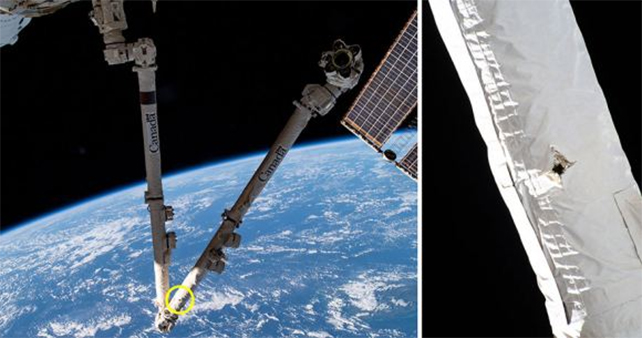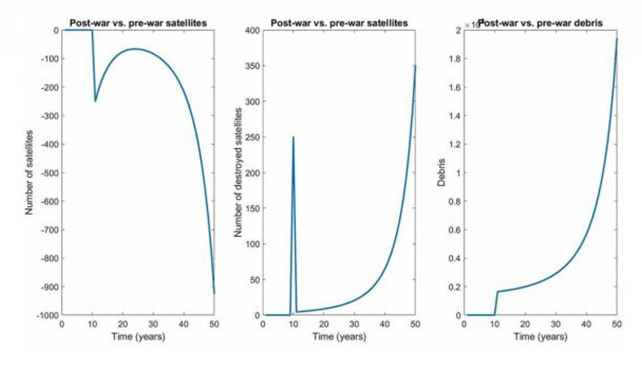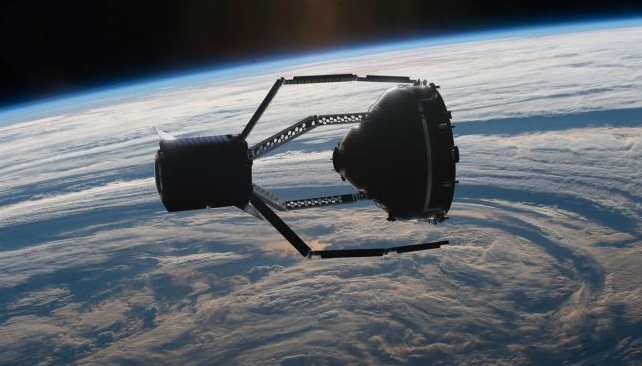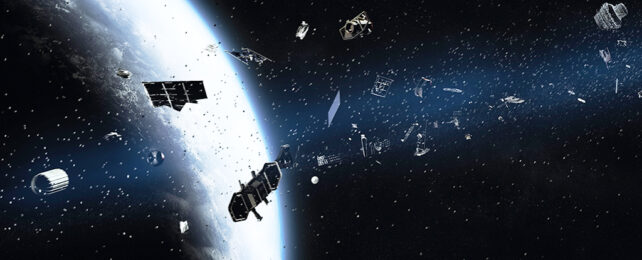On one particular day in 2021, astronauts and cosmonauts aboard the ISS must have felt a pin-prick of fear and uncertainty. On November 15th of that year, Russia fired an anti-satellite missile at one of its own defunct military satellites, Tselina-D.
The target weighed about 1,750 kilograms, and when the missile struck its target, the satellite exploded into a cloud of hazardous debris.
NASA woke the crew on the International Space Station in the middle of the night and told them to take precautions and prepare for a possible impact. The Chinese space station Tiangong was also in danger, and multiple countries and space agencies condemned Russia's foolhardy behavior.
But there was no way to contain the debris.
That event highlighted the risk of ASAT (anti-satellite) weapons. According to recent research, the cloud of debris from a shattered satellite could create a cascade of additional collisions that would make LEO unusable in about 40 years.
"Space activities underpin our way of life, and this kind of behavior is simply irresponsible."
Army General James Dickinson, commander of U.S. Space Command.
The cloud of debris from the 2021 explosion contained more than 1500 debris fragments larger than 10 centimeters that were trackable by ground-based radar. It also created hundreds of thousands or even millions of smaller pieces. According to NASA, the debris cloud spread from 300 kilometers in elevation up to 1,100 kilometers and constituted a perilous hazard to other satellites and orbiting spacecraft.
"The debris created by Russia's (test) will continue to pose a threat to activities in outer space for years to come, putting satellites and space missions at risk, as well as forcing more collision avoidance maneuvers," said Army General James Dickinson, commander of US Space Command at the time.
"Space activities underpin our way of life, and this kind of behavior is simply irresponsible."
This is why the US announced an end to testing anti-satellite weapons in space: they're impractical.
While some countries, particularly ones with an authoritarian leaning, would like to place weapons in space as a kind of orbital saber-rattling, the reality of actually using one to destroy a foe's satellite can be counter-productive. The debris is just as likely to damage your own satellites as it is your adversary's.
Russia's 2021 ASAT test wasn't the only time a country tested a weapon against a satellite. In fact, countries have been testing anti-satellite weapons since the 1950s when satellites were growing in number, launched by the USA and their cold-war rival, the USSR.
As soon as there were targets, both sides developed weapons to strike them. Since those early years of the space age, there've been dozens of ASAT tests. Russia, China, the USA, and India have all conducted them.
The first test of a direct-ascent ASAT, meaning one that is launched into orbit, occurred in 1957. The US launched their High Virgo weapon from a B-58 bomber prototype. The target was their own Explorer 5 satellite, though the weapon's telemetry failed, and the test was inconclusive. Testing continued into the future, with ASATs being launched from the ground, sea, and air.
Eventually, the Outer Space Treaty of 1967 prohibited placing weapons in space. But an anti-satellite (ASAT) weapon needn't be in space. That's why in 2022, the US announced their own ban on testing ASATs of all types.
President Biden's administration confirmed that they enacted their ban in order to encourage other countries to follow them. They're aware of the potential consequences of ASATs that are laid out in detail in a new research article.
The article is "Star Wars: Anti-Satellite Weapons and Orbital Debris," and it's published in the journal Defence and Peace Economics. The authors are Anelí Bongers and José L. Torres. Bongers is from the Department of Economics and Economic History at the University of Málaga in Spain, and Torres is from the Faculty of Economics and Business Sciences at the same university.
This is the situation, according to the authors. There are already about 6,000 satellites in orbit and a staggering 131 million pieces of debris between 1 millimeter and 10 centimeters in size. The debris travels at about 36,000 kilometers per hour, and at that speed, even a small chunk can damage a satellite or space station.
In May 2021, a tiny piece of debris struck the Canadarm2 on the ISS and punched a small hole in it.

"Any piece larger than 1 centimeter is potentially lethal in case of collision," said Professor Torres, co-author of the research article.
Russia's ASAT test in 2021 created a measurable portion of the orbital debris, and the more debris there is, the greater the risk from additional ASATs.
The authors of the research article point out how the Kessler syndrome could eventually play out. The Kessler syndrome describes a cascade of collisions so numerous that in only forty years after an ASAT test, all of our satellites would be destroyed, overwhelmed by collisions and a cloud of debris that makes Low-Earth Orbit (LEO) unusable.
"The calculations also show that anti-satellite tests generate more than 102,000 new pieces of this waste larger than 1 centimeter and that its negative effects take 1,000 years to disappear due to the high altitude at which tests are carried out," the authors explain.
Orbiting satellites are rapidly becoming more and more important to economics and to geopolitics. ASAT tests deliberately create more debris that imperils satellites' ability to operate safely and constitute an economic risk.
The Kessler syndrome, also known as collisional cascading, is the worst possible outcome of weapons testing. But even if we avoid that outcome, the growing problem of debris from past tests and other space activities is also threatening our satellites and the benefits that flow from them. And the more Earth's orbital regions are choked with debris, the more it limits the launch of additional satellites and all the benefits that accrue.
Because they're economists, the authors look at space from a specific angle. In their lexicon, orbital space is an 'unregulated market.'
In economics, unregulated markets can become overexploited in a 'tragedy of the commons' scenario. In those scenarios, users rush in to exploit a new resource, but since there are not enough robust rules, the group exploitation degrades the resource, making it less usable for everyone.
"We are faced with a huge unregulated market, in which problems have just started," the researchers write.
The problems may have just started, but the potential endgame is catastrophic. An all-out war in space between two superpowers like China and the USA is the ultimate tragedy of the commons. Military satellites are high-value targets, and there's a strong possibility that in any serious conflict, satellites would be targeted. This is where the future looks bleak, according to the authors, as things could escalate quickly.

"The weaponization of outer space means that Earth's orbit has become another battlefield for the main powers, as enemy satellites are high-value military assets whose destruction denies the enemy forces critical capabilities," the authors write.
"As is recognized by the main powers, space is a new and increasingly important domain for fighting wars."
There may be no way of winning a superpower war on Earth without targeting satellites. "The destruction of enemy satellites, not only military ones but also civil ones as the latter also have a military use, would be critical for winning a war on Earth."
Precision munitions used in a surface war rely on satellites to hit their targets, so those satellites would be critical command and control components and would certainly be targeted.
It's clear that countries with space capabilities are in an arms race, despite the USA saying they wouldn't test any more ASATs. Weapons can be developed without orbital testing. In fact, any satellite with propulsion can be used as an ASAT. This highlights the problem with banning ASATs based in space.
Rendezvous and Proximity Operations (RPO) refers to any spacecraft that intentionally maneuvers, docks, or operates in close proximity to another satellite or spacecraft. These types of satellites can be used to boost decaying satellites back up to a higher elevation and increase their lifespan. They can also refuel and potentially repair satellites. Satellites that are designed to remove space debris also conduct RPOs.

But when is an adversary's RPO satellite a weapon? Any satellite with propulsion can be used as a kinetic impactor, and if a country wanted to be really devious, there's no way to prevent them from launching an ASAT under the guise of an RPO satellite. In this scenario, a country can test ASATs without causing alarm.
There's a historical precedent for this orbital wolf-in-sheep's-clothing scenario. In 1974, the Soviet Union launched a peaceful space station called Salyut 3. But it was actually part of their top-secret Almaz military space station program disguised as s Salyut station. That same type of deception is unlikely to go undetected in modern times, but it shows willingness.
It may seem futile, dumb even, for humanity to export its combative nature into space, but only the naive can be surprised by it. It's a natural outcome.
"The militarization of outer space can be considered as a natural and inevitable process once access to space became technologically feasible, given the wide range of strategic advantages of space for military activities," the authors write.
"In principle, it can be argued that the militarization of outer space does not pose any risk in that environment, except by further congesting the orbit and radio spectrum with military satellites in a similar way to other civil and commercial activities."
Until conflict boils over and weaponized satellites are used for their intended purpose.
If that happens, then it mirrors the result of a hypothetical nuclear exchange in a terrestrial war.
Mutual Assured Destruction (MAD) is a military doctrine that ensures once one side launches a nuclear weapon, the other side will, too. A large enough exchange of nuclear weapons would have global consequences, and no nation-- not even peaceful, neutral, non-aligned countries – would escape the suffering. MAD is both insane and rational at the same time, and a conflict that destroyed our fleets of satellites would be similar.
In a war, once one side targeted satellites, the other side(s) would, too. All the resulting debris would destroy Earth's orbital environment and clog it with millions of pieces of dangerous debris. Again, even non-aligned nations would see their satellites succumb to the cascade of collisions that would result from a war in orbit.
"In this hypothetical war scenario," the authors write, "all the foes would lose, and the near-Earth orbit would be rendered completely useless for any human activity, with global negative consequences for all nations."
What can be done?
"Given the physical characteristics of the outer space environment and the technical characteristics of satellites and other spacecraft, banning or limiting the weaponization of outer space is extremely difficult, if not impossible," the authors write in their conclusion. They point out that in space, anything with mass is a potential weapon that can be used as an impactor because of high velocities.
They point out the difficulties of tracking vehicles in space and determining their design and intent. And space is common territory, so it's not as simple as monitoring a single country's territory on Earth's surface. Any effort to track and identify potential ASATs is mired in complexity, especially since RPOs will become even more common as space agencies try to grapple with the space debris problem.
In the end, the nuclear arms race and MAD might hold the key to controlling satellite warfare. There's been no nuclear war and no war between superpowers since the advent of nuclear stockpiles. The consequences can be so dire and uncontained that everyone would suffer.
Let's hope nations can keep that in mind as they expand into space and bring more military capabilities with them.
This article was originally published by Universe Today. Read the original article.
